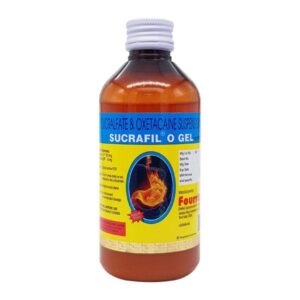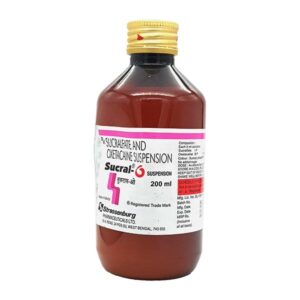SUCRALFATE + OXETACAINE
Sucralfate: Sucralfate is a medication mainly used to treat and prevent ulcers in the stomach and intestines. It can also be prescribed for conditions like gastroesophageal reflux disease (GERD) and to prevent damage caused by nonsteroidal anti-inflammatory drugs (NSAIDs).
The mechanism of action of sucralfate involves the formation of a protective barrier over the ulcers or irritated areas of the gastrointestinal tract. It works by binding to the proteins present in the ulcer, forming a thick gel-like substance that acts as a physical barrier. This barrier shields the ulcer from the acid in the stomach, preventing further damage and promoting healing.
The typical dose of sucralfate is 1 gram (g) four times a day, usually taken on an empty stomach. It is essential to follow the prescribed dosage instructions provided by your healthcare provider.
Common side effects of sucralfate include constipation, dry mouth, upset stomach, and flatulence. These side effects are generally mild and temporary. However, if you experience severe or persistent side effects, it is crucial to consult your doctor.
It is important to note that sucralfate can interact with other medications, such as antacids, cimetidine, digoxin, phenytoin, and many others. Therefore, it is essential to inform your doctor about all the medications you are currently taking to avoid any potential drug interactions.
Overall, sucralfate is a medication that forms a protective barrier over ulcers and irritated areas in the gastrointestinal tract, promoting healing and prevention of further damage. It is commonly used for treating ulcers and related conditions and has a generally favorable side effect profile when used as directed by a healthcare professional.
Oxetacaine: Oxetacaine is a drug from the class of local anesthetics. It is primarily used to provide relief from pain and discomfort caused by conditions such as dental procedures, mouth ulcers, sore throat, and gastroesophageal reflux disease (GERD).
The mechanism of action of Oxetacaine involves blocking the transmission of pain signals by inhibiting the function of sodium channels in nerve cells. It also acts by numbing the affected area, providing local anesthesia.
Oxetacaine is available in the form of oral gel or spray, and the dose may vary based on the specific condition being treated. Typically, for oral use, a small amount (around 2-4 mL) of the gel is applied to the affected area and left undisturbed for a few minutes. For throat pain, the spray form is used by directing 1 or 2 sprays towards the back of the throat. It is important to follow the instructions provided by the healthcare professional or on the product label.
Common side effects of Oxetacaine may include mild burning or stinging sensation at the application site, temporary numbness, and altered taste perception. These side effects are generally mild and self-limiting. However, if any severe or persistent side effects occur, it is important to seek medical attention immediately.
It is essential to note that Oxetacaine should not be used in large quantities or for prolonged durations without medical supervision, as excess usage can lead to systemic absorption and a higher risk of side effects. It is always advisable to consult a healthcare professional before starting any medication.



